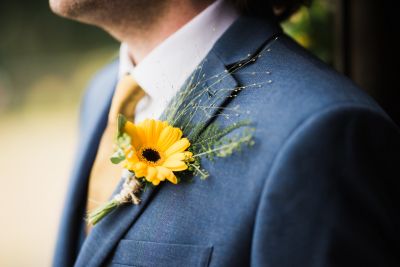
If you’ve got a big occasion coming up, chances are, you’ve probably been stressing about how to wear a buttonhole for the wedding for some time. Buttonholes come in all different styles, shapes and sizes, and are just as varied as the occasions themselves. Sometimes, they can be given by the couple to their guests. Other times, they can be chosen and bought, or even made by the wearer.
And then there’s the matter of figuring out how to wear them!
To help you understand the ins and outs of buttonholes, we’ve created this handy guide. Below, you can find out more about everything from the tradition of wearing buttonholes, to the best way to wear yours.
What are buttonholes for weddings?
A buttonhole is the name for a small decorative flower (or bunch of flowers), which is worn in the suit’s lapel. These are positioned in the lapel’s buttonhole - hence their name. But, they are also commonly referred to as a boutonnière.
Common flower choices for buttonholes include a rose, carnation, waxflower, lavender or gypsophila. These can be either cream or coloured, depending on the style and theme of the wedding.
Also, another common trend that we’ve seen in recent years is the use of foliage in buttonholes. These include leaves like eucalyptus and ivy, to give the buttonhole a more rustic, natural look.
Who wears buttonholes at weddings?
Most commonly, buttonholes are worn in the suits of the couple’s immediate family members, or key members of the wedding party.
These include (as well as the groom), the best man, ushers, the fathers or step fathers of the couple, and brothers. If any women in the wedding party are wearing a suit, they’d also be asked to wear a buttonhole.
Sometimes, couples request that bridesmaids pin buttonholes to their dresses.
The buttonholes typically match the colour scheme and flower arrangements that the couple have chosen for the wedding.
When did people start wearing buttonholes at weddings?
It’s interesting to consider how flowers have, throughout history, had such a key role in men’s fashion.
In the early 19th century, buttonholes rose in popularity as a men’s accessory. This coincided with the rise of jackets that included a Ghillie collar. When wearing these jackets, the men kept the top buttons undone, allowing the right side of the jacket to flap over, exposing the buttonhole of the left side of the jacket.
These exposed holes were decorated by flowers, in keeping with the styles of the Romantic movement. They were popular as they gave men an opportunity for individual expression, helping them to stand out amongst their acquaintances.
These buttonholes soon became established as an elegant accessory, worn by stylish upper-class men. And the rest is history.
Which side should you wear buttonholes for weddings?
Owing to their long-standing tradition, there are a number of rules that govern how exactly you should wear your buttonhole.
The buttonhole should be worn on the jacket’s left lapel. Most formal jackets will already come with a strong buttonhole (which is reinforced, so that it can successfully carry the flowers). Some will even include a latch that can be used to secure the flower stems.
How to make buttonhole flowers for weddings
In some cases, the couple will have a very clear idea of what they want the buttonholes to look like. If so, they’ll most likely either supply you with a buttonhole, or give you very clear instructions on the colours and types of flowers that they want your buttonhole to contain.
Or, if you’d like to wear a buttonhole, but you haven’t been given a brief from the couple, you can choose to make your own!
It’s super simple, and a great way to create a stylish (and cheap!) customised accessory to adorn your suit.
To create your own buttonhole flowers, we’d recommend following the steps below:
- Choose your flowers - you could choose a single flower, a cluster of matching flowers, or a combination of flowers and foliage. You also need to consider how the different colours (if you’re using any) go together, and how it all matches up with your suit.
- Cut the stems of your flowers, and leave them in a vase of water overnight. This will keep the flowers fresh, strong and vibrant.
- Thread the flowers with wire. Get your florist’s wire (you can easily buy this online) and thread it through the calyx of the flower. Thread the wire through until it is poking out of the other side of the flower. Then, keep pushing until you have enough wire to loop it back on itself, and push it back through the flower’s calyx. This will keep the flower supported and upright throughout the ceremony - no one wants a wilting buttonhole!
- Arrange your flowers, then unite them all together with stem tape.
- Pop the flowers in your lapel, and you’re all set!
Those in the wedding party who are jammy enough to wear a suit have very little to worry about! Once you’ve chosen your tie, you can dig up the suit you wore to the last occasion.
But, the buttonhole is the accessory that takes this outfit a level up; setting it apart as a classic, elegant wedding suit, rather than the garb that you’d wear to your work party.
So, we’d encourage you to spend a little extra time choosing and arranging your buttonhole. It’ll really elevate your outfit, and show the couple how much you respect both them and their special day.




